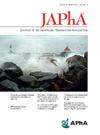评估宾夕法尼亚州药学人员健康培训需求的行为健康和社会决定因素。
IF 2.5
4区 医学
Q3 PHARMACOLOGY & PHARMACY
Journal of the American Pharmacists Association
Pub Date : 2025-05-01
DOI:10.1016/j.japh.2025.102363
引用次数: 0
摘要
背景:超过三分之一的美国人生活在无法获得精神卫生资源的地区。在社区中,药房人员是一种值得信赖和可获得的资源,使他们能够成为有行为健康(BH)或健康社会决定因素(SDOH)需求的个人的联络点。然而,药学人员可能没有受过培训,也没有信心提供这种支持。目的:本研究的目的是确定宾夕法尼亚州药学人员的BH/SDOH培训差距。方法:对宾夕法尼亚州药师协会会员进行电子需求调查。调查项目引出了受访者在提供某些BH/SDOH服务方面的自我报告舒适感,自我报告获得相关资源的机会,以及对真假评估问题的了解。先验地选择人口统计信息(执业区域、社区执业类型、职称、先前培训),以确定子类别内是否存在差异。采用卡方检验确定统计学显著性;α设为0.05。结果:140名受访者完成了调查,其中54%确定为药剂师,52%在郊区执业。41%的受访者表示,他们对评估一个人的自杀或伤害风险感到自在,32%的受访者表示,他们能够将病人转介到当地的无家可归者收容所。少数受访者正确回答了所有与精神卫生急救相关的评估问题(43%)。与非药剂师人员相比,药剂师愿意提供BH信息的比例有统计学意义(64%对41%,p=0.01),但不愿意提供其他服务。在实践区域设置或社区实践类型方面,报告的舒适度没有统计学上的显著差异。结论:本研究表明,药学人员对提供BH/SDOH服务有一定程度的经验和舒适度,但差距仍然存在。我们期望通过额外的培训,药房人员可以成为帮助照顾有BH/SDOH需求的患者的倡导者。本文章由计算机程序翻译,如有差异,请以英文原文为准。
Assessing the behavioral health and social determinants of health training needs of Pennsylvania pharmacy personnel
Background
Over one-third of Americans live in areas without access to mental health resources. Pharmacy personnel are a trusted and accessible resource in the community, allowing them to be a point of contact for individuals with behavioral health (BH) or social determinants of health (SDOH) needs. However, pharmacy personnel may not have the training or the confidence to provide that support.
Objective
The purpose of this study was to identify the BH/SDOH training gaps of Pennsylvania pharmacy personnel.
Methods
An electronic needs survey was distributed to members of the Pennsylvania Pharmacists Association. Survey items elicited respondents' self-reported comfort in providing certain BH/SDOH services, self-reported access to related resources, and knowledge on true-false assessment questions. Demographic information (area of practice setting, type of community practice, job title, prior training) was selected a priori to determine if there were differences within the subcategories. Chi-squared tests were performed to determine statistical significance; α was set at 0.05.
Results
A total of 140 respondents completed the survey, with 54% identifying as pharmacists and 52% practicing in a suburban setting. Forty-one percent of respondents reported feeling comfortable assessing an individual for risk of suicide or harm and 32% reported being able to refer patients to local homeless shelters. A minority of respondents answered all Mental Health First Aid-related assessment questions correctly (43%). A statistically significant higher percentage of pharmacists were comfortable providing information on BH compared to nonpharmacist personnel (64% vs. 41%, P = 0.01) but not for other services. There was no statistically significant difference in reported comfort by area of practice setting or by type of community practice.
Conclusion
This study demonstrates that pharmacy personnel have some level of experience and comfort with providing BH/SDOH services, but gaps remain. We expect that with additional training, pharmacy personnel can become advocates to help care for patients with BH/SDOH needs.
求助全文
通过发布文献求助,成功后即可免费获取论文全文。
去求助
来源期刊
CiteScore
3.30
自引率
14.30%
发文量
336
审稿时长
46 days
期刊介绍:
The Journal of the American Pharmacists Association is the official peer-reviewed journal of the American Pharmacists Association (APhA), providing information on pharmaceutical care, drug therapy, diseases and other health issues, trends in pharmacy practice and therapeutics, informed opinion, and original research. JAPhA publishes original research, reviews, experiences, and opinion articles that link science to contemporary pharmacy practice to improve patient care.

 求助内容:
求助内容: 应助结果提醒方式:
应助结果提醒方式:


